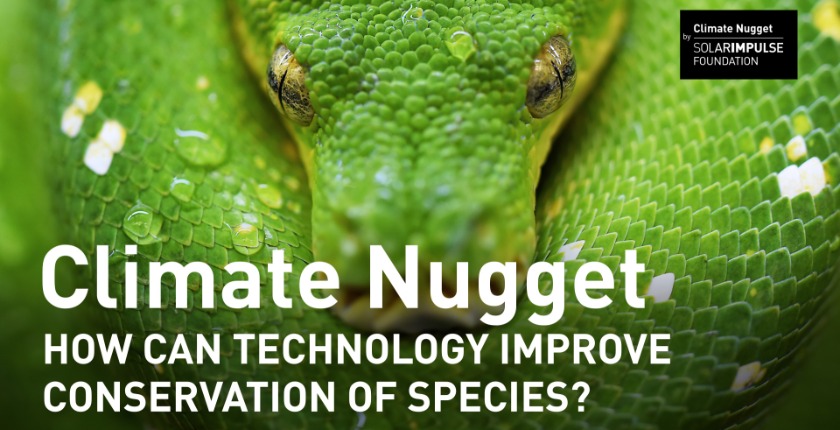Climate Nugget - April 18, 2019
Technologies to protect biodiversity


Written by Tristan Lebleu 4 min read
Discovering individual animals, following their movements, identifying and locating animal and plant species, assessing their habitat, and preventing poaching are just a few examples of actions taken by conservationists to protect our planet’s incredibly diverse biodiversity. Technology is here to help them.
The sixth mass extinction. This is how scientists have named the shocking decline of species that the Earth is currently witnessing. But while the five precedent had been provoked by catastrophic events, such as asteroid collisions, this one is caused by human activities. The latest Living Planet Report, produced by WWF and over 50 scientists from across the globe, estimates that “population sizes of wildlife decreased by 60% globally between 1970 and 2014”. “We are sleepwalking towards the edge of a cliff” warned Mike Barrett, executive director of science and conservation at WWF, in an interview with the Guardian.
The main cause of this extinction of wildlife is natural habitat loss, as currently three-quarters of all land on the planet are used for agriculture, industry, and urbanization, according to the report. Killing for food is the second biggest cause, with 300 mammals being “eaten into extinction”, and chemical pollution quickly follows. Not only is this tragic in itself, but it also threatens the well-being of current and future generations, as our survival directly depends on healthy ecosystems. “This is actually now jeopardising the future of people. Nature is not a ‘nice to have’ – it is our life-support system” Mike Barrett told the Guardian.

To slow the pace of this distressing trend, conservation efforts are crucial. In recent years, conservation has been improved by technology such as Unmanned Aerial Vehicles (UAVs), IoT sensors, crowdsourcing, and machine learning. As we celebrate the 49th edition of Earth Day dedicated to biodiversity, we’ve decided to focus on emerging technologies and solutions that are helping us “Protect our Species”.
Drones
Unmanned Aerial Vehicles, more commonly known as drones, have become a great ally to conservationists. Indeed, they can help monitor species by providing aerial images of large areas that are sometimes difficult to access. Recently, scientists made a breakthrough discovery for wildlife monitoring: thermal cameras were fitted on drones and flew above the Bornean forest to identify orangutans from their heat signatures. The experiment, conducted by astrophysicists, conservationists and ecologists, was very successful as 41 orangutans were spotted over 2 days.
In the future, we hope to be able to track, distinguish and monitor large numbers of different species of animals in real time, all around the globe, so that this technology can be used to make a real impact on conservation and stop poaching before it happens.
Dr Claire Burke, an astro-ecologist at Liverpool John Moores University, in an interview with Verdict
While drones are now widely used to monitor forests, they could also be highly effective to restore them. Indeed, tree-planting drones are being tested all around the world. Drones are first used to map an area and decide where trees need to be planted, they are then loaded seeds - usually in biodegradable pods - and the seeds are dropped. The company BioCarbon Engineering is working on a massive project in Myanmar to restore mangroves. Over six million trees have been planted so far, and another four million should be planted by the end of 2019. Restoration of forests is not only imperative for preserving biodiversity, it could be a game-changer in the fight against climate change. A recent study from Thomas Crowther, an ETH Zurich professor, describes how planting 1.2 trillion new trees around the world could absorb more CO2 than human emit each year.
IoT
While IoT is now widely used for smart homes applications, as well as in agriculture (see our recent article about the Future of Farming), it has also become a life-saver for many endangered species. As poaching intensifies around the world - elephants, rhinos, lions, pangolins, and iconic African wildlife could even disappear within our lifetime - IoT is used to track animals and prevent poachers from harming them. In 2017, the Sigfox Foundation, (from the French startup Sigfox which operates a global network for connected objects) has developed a tracking solution combining GPS technology and its low-powered IoT connectivity to monitor rhinos. By using its secured and long-term tracking system, conservationists can have a real time and exact locations of the animals and therefore better protect them. Project RAPID (Real-time Anti-Poaching Intelligent Device) even combines the GPS trackers with a camera and a heart rate monitor to intervene as soon as the animal seems to be distressed.
By only transmitting a few GPS positions every day, we drastically simplify the tracking and monitoring of endangered wildlife. We now give a voice to rhinoceroses, everyday, wherever they are. It is a big hope to better understand endangered species, so to protect them.
Marion Moreau, head of the Sigfox Foundation.
Connected devices have also been deployed to listen to forests. Rainforest Connection, a San Francisco-based organisation, has created a control system based on acoustic monitoring. Once their sensors attached to trees, they can detect illegal logging through chainsaw sounds, halt poaching and even enable bio-acoustic monitoring of certain species.
Crowdsourcing
While drones and sensors can provide valuable information to monitor animals, another trend is improving conservation efforts and helping scientists: crowdsourcing. According to a 2015 study which tried to estimate the number of visits in Protected Areas through an approximation model, PAs receive roughly 8 billion visits per year. All of these tourists create invaluable amounts of data on plant and animal species for scientists, ecologists and conservationists. That is the goal of iNaturalist, a joint initiative between The California Academy of Sciences and the National Geographic Society. It allows amateur observers to upload their photos on the app and share their observations with a community of 750’000 scientists. Thanks a machine-learning algorithm, iNaturalist automatically suggest what species is on the picture.
However clever and efficient these technologies might be, “New technologies alone do not save species” say Stuart Pimm and Zoe Jewell in their landmark study on "Emerging Technologies to Conserve Biodiversity". Indeed, in addition to conservation efforts, it will take a massive change in consumption and production models to truly halt the “sixth mass extinction”.

Written by Tristan Lebleu on April 18, 2019


